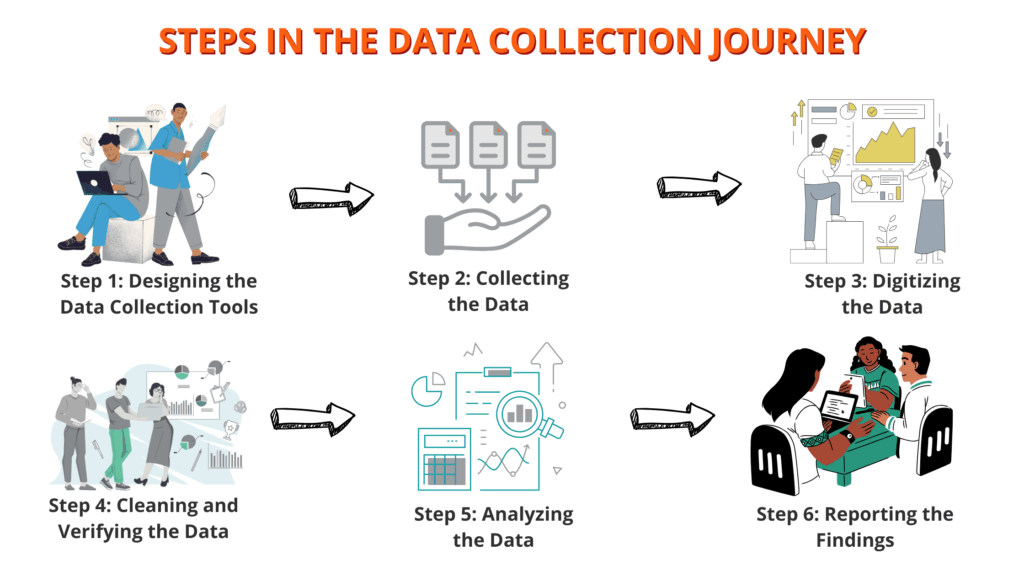How to map out your data collection journey
Data collection isn’t just the responsibility of the Monitoring and Evaluation (M&E) Officer — it’s a team effort. Whether you’re collecting data for a new project or ongoing monitoring, it’s crucial to break down the process into clear, manageable steps. In the context of M&E, “data journey” refers to the process of collecting, managing, analyzing, and using data to assess your program or projects’ effectiveness and impact. It involves a series of steps, from identifying data needs to communicating findings, ensuring data quality throughout the process.
Let’s walk through the data collection journey — from the initial design of the data collection tools all the way to the final reporting.

Steps in the Data Collection Journey
1. Designing the Data Collection Tools
The first step in the data collection process is to design tools that are tailored to your project’s goals and indicators. This includes crafting surveys, questionnaires, observation forms, or any other tools you’ll use to gather data. Consider the types of tools, the sample population and sample size.
Who’s responsible?
Project managers, M&E officers, or data specialists typically lead this step, with input from subject matter experts and program staff to ensure the tools align with project outcomes.
2. Collecting the Data
Once the tools are in place, it’s time to collect the data. This could involve field visits, interviews, surveys, focus groups, or community observations. Clear guidelines and training of enumerators should be in place to ensure data is gathered consistently and ethically. Consider the data collection frequency in relation to your reporting needs.
Who’s responsible?
Field staff, local partners, and data collectors take the lead here, with guidance and oversight from the M&E team.
3. Digitizing the Data
After collection, it may be necessary to digitize any data that was collected on paper. This can involve entering data into spreadsheets or uploading it into software to ensure it’s ready for analysis.
Who’s responsible?
Data entry specialists, field staff, or project assistants usually handle this, ensuring data is accurately transferred into the system.
4. Cleaning and Verifying the Data
With digitized data in hand, the next step is data cleaning. This ensures that the data is accurate, complete, and free of errors. You’ll also want to verify that no data points are missing or inconsistent, as this could skew analysis.
Who’s responsible?
Data analysts or M&E officers typically lead this phase, with support from data entry teams to check for mistakes or discrepancies.
5. Analyzing the Data
Once your data is clean, it’s time for analysis. The goal here is to extract valuable insights and identify trends, patterns, and any significant findings that can inform your project’s progress.
Who’s responsible?
Data analysts, M&E officers, or evaluators are usually in charge of analyzing the data, often in collaboration with subject matter experts and project managers to ensure it aligns with the project’s objectives.
6. Reporting the Findings
Finally, the analyzed data needs to be communicated to stakeholders in a clear and digestible format. Reports should include key findings, insights, and any actionable recommendations. The format of the report will vary depending on the audience (donors, partners, team members).
Who’s responsible?
M&E officers, project managers, subject matter experts and communication specialists typically lead this step, making sure the information is presented in an accessible and engaging way.
______________
It’s important to note that these steps aren’t isolated — they overlap, and each one requires input from multiple team members. By identifying who is responsible for each step and ensuring that everyone involved understands their role, you can streamline the data collection process and ensure its success.
Tip: Turning this into a team exercise, where each member helps define their responsibilities, is a great way to engage the whole team and ensures everyone is on the same page and has a shared understanding of the data collection process. We like to use a large grid that lists each tool as a row and each step as a column, then have team members select an emoji to represent them and add that emoji wherever they are involved. This is an interactive activity that creates a visual overview that everyone can refer back to.
Conclusion
Effective data collection is critical to the success of any project. By breaking down the journey into clear, defined steps, you not only keep the process organized but also make it easier for your team to track progress and identify areas for improvement.
Is your team ready to tackle the data collection journey? With the right tools and a clear plan in place, you’re set for success — and maybe even a little fun along the way!



